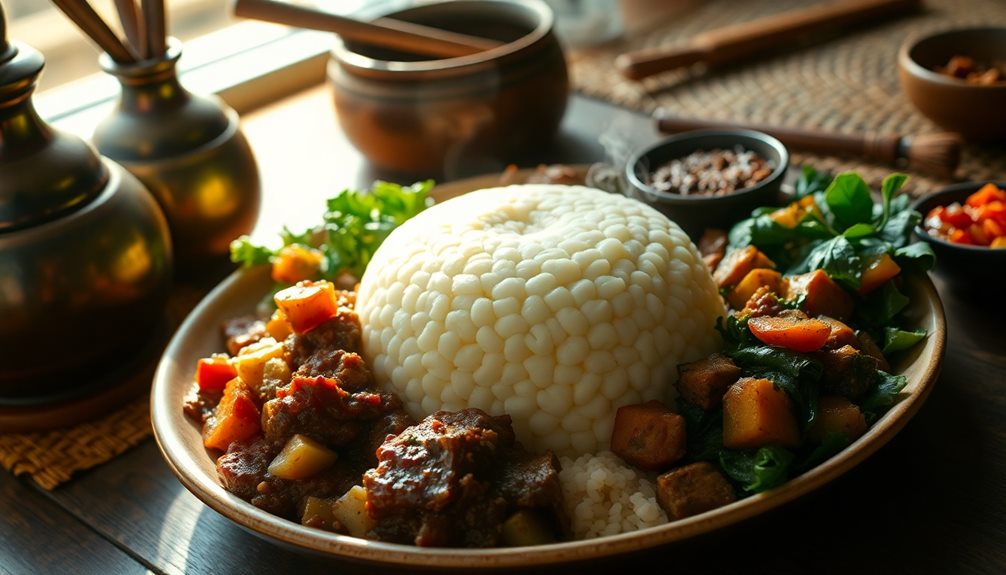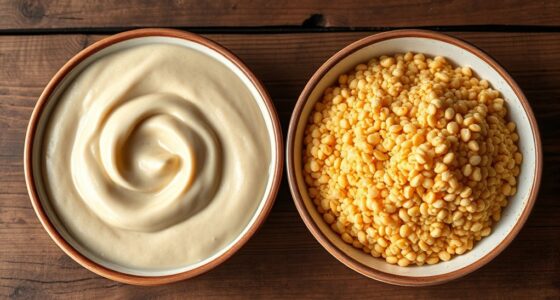Sadza, Zimbabwe's beloved cornmeal dish, is a time-honored culinary treasure that connects generations, nourishes the soul, and brings families together in joyful celebration. Tracing its roots to ancient agricultural practices, this versatile staple reflects the vibrant culture of the Shona and Ndebele peoples. To craft the perfect batch, simply boil water, gradually stir in cornmeal, and simmer until the desired creamy texture emerges. Serve it hot with savory stews, fresh greens, or your favorite condiments for a truly comforting experience. With a bit of practice, you'll soon master this beloved dish that's at the heart of Zimbabwean cuisine – and there's much more to discover.
Key Takeaways
- Sadza is a traditional Zimbabwean staple food made from finely ground maize flour, with a rich history and cultural significance.
- The recipe includes simple ingredients like maize flour, water, and salt, with optional additions like butter or margarine.
- The cooking process involves boiling water, gradually incorporating the flour, simmering to achieve the desired consistency, and serving hot.
- Key tips for success include patience, close monitoring of the cooking process, and experimenting with different textures.
- Sadza is commonly served with savory stews, fresh greens, or condiments, and the communal preparation and shared meal experience reflect Zimbabwean cultural traditions.
History
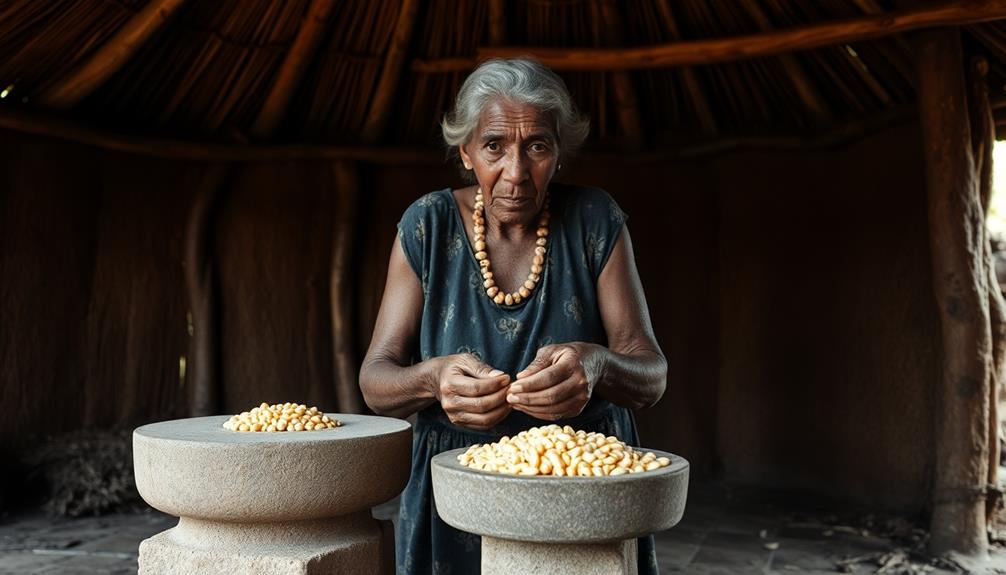
Originating from the African continent, sadza is a staple food deeply rooted in the culinary traditions of various regions. This beloved dish has been a part of Zimbabwean culture for generations, nourishing families and bringing them together.
The history of sadza can be traced back to the ancient agricultural practices of the Shona and Ndebele peoples, who cultivated the staple grains used in its preparation.
Over time, the recipe for sadza has been passed down, evolving to suit the tastes and preferences of local communities. Today, it remains a cherished part of Zimbabwean identity, enjoyed during special occasions and daily meals alike.
Whether served with savory stews, grilled meats, or simply accompanied by fresh greens, sadza is the ultimate comfort food that connects people to their cultural heritage. Its enduring popularity is a testament to the rich culinary traditions that have sustained Zimbabwean communities for generations.
Recipe
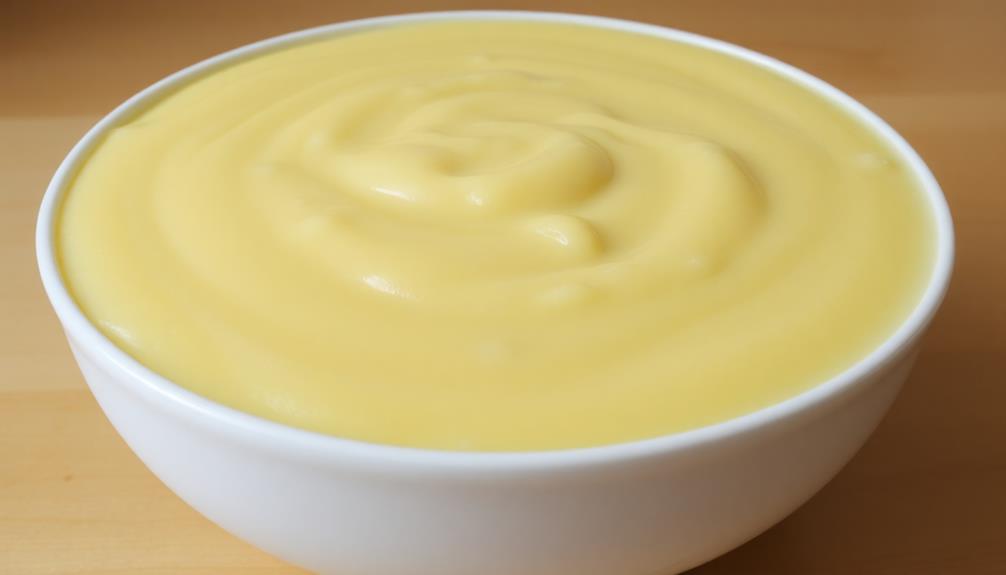
Sadza is a traditional staple food in many parts of Southern Africa, particularly Zimbabwe. It's a thick porridge made from finely ground maize flour, also known as mealie meal. Sadza is a versatile dish that can be served as a side or the main component of a meal, often accompanied by various relishes or stews.
The process of making sadza is relatively straightforward, but it requires patience and attention to achieve the desired texture and consistency. Sadza is a fundamental part of the culinary heritage of the region and is deeply rooted in the cultural traditions of the people.
Ingredients:
- 2 cups finely ground maize flour (mealie meal)
- 4 cups water
- 1 teaspoon salt
Instructions:
In a medium-sized pot, bring the 4 cups of water to a boil over high heat. Once the water is boiling, gradually add the maize flour while stirring constantly with a wooden spoon or a whisk to prevent lumps from forming.
Reduce the heat to low and continue stirring the mixture until it thickens to a smooth, porridge-like consistency, which should take about 10-15 minutes.
Once the sadza has reached the desired thickness, cover the pot and let it simmer for an additional 5-10 minutes, stirring occasionally. During this time, the sadza will continue to thicken and become more cohesive.
Finally, stir in the salt and serve the sadza hot, either as a side dish or as the main component of a meal, accompanied by your choice of relishes, stews, or vegetables.
Tips:
- For a creamier texture, you can add a small amount of butter or margarine to the sadza towards the end of the cooking process.
- If the sadza becomes too thick, you can thin it out by adding a small amount of hot water and stirring until the desired consistency is reached.
- Leftover sadza can be stored in the refrigerator and reheated the next day, adding a bit of water to restore its texture.
Cooking Steps
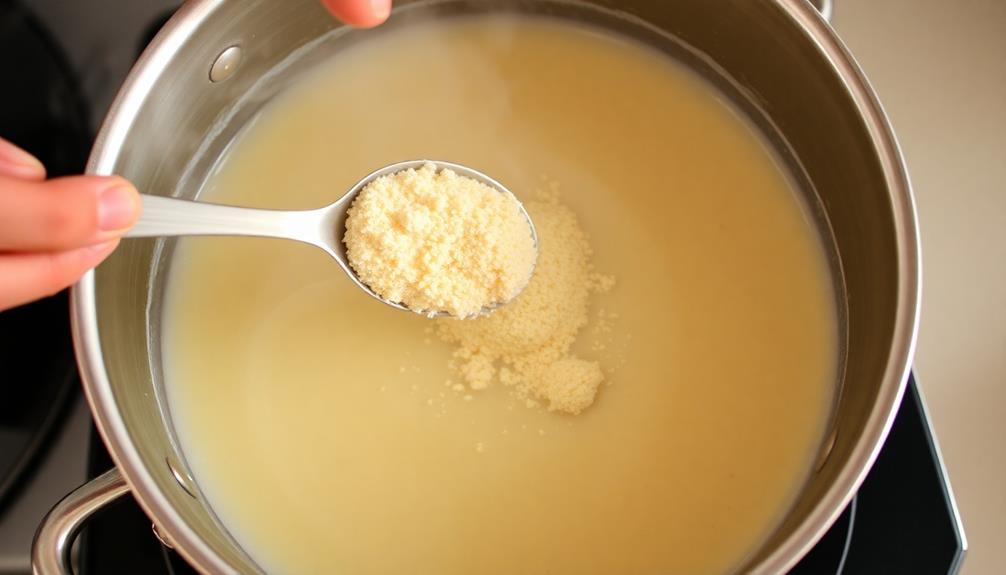
Bring that water to a boil, then gently stir in the cornmeal.
Once it's all mixed in, reduce the heat and let it simmer until it thickens up.
Don't forget to cover the pot – you want that sadza nice and hot when you serve it up with your favorite accompaniments.
Step 1. Bring Water to a Boil
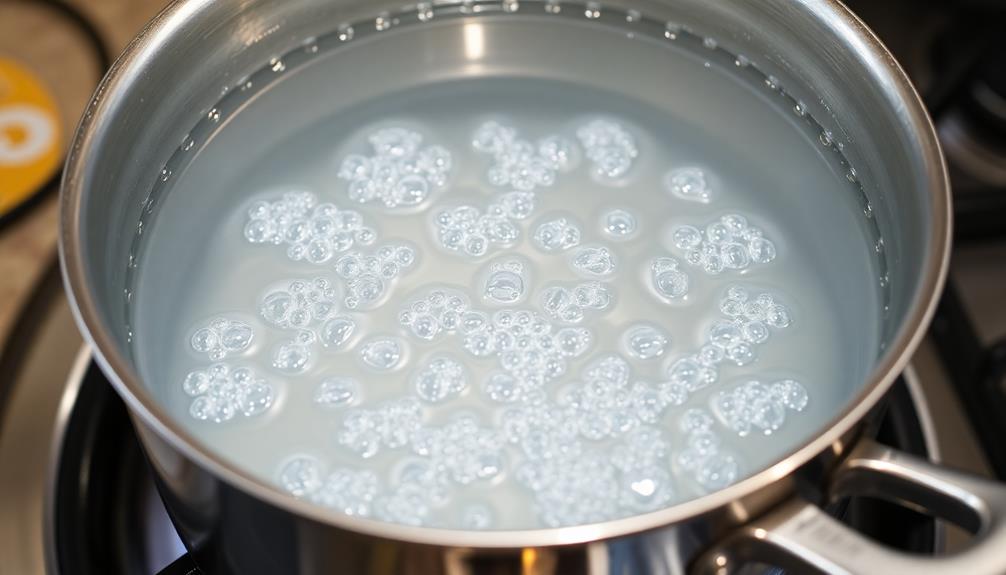
First, bring a large pot of water to a rolling boil over high heat. You'll want to keep a close eye on it, as you don't want the water to boil over.
Once the water is at a full, bubbling boil, it's time to start adding your sadza.
Measure out the correct amount of sadza flour based on the number of servings you're making. Slowly pour the flour into the boiling water, whisking constantly to prevent any lumps from forming. The key is to add the sadza in a steady stream, mixing thoroughly as you go.
Continue stirring and cooking the sadza for about 5-7 minutes, until it reaches the desired thick and creamy texture. You'll know it's done when the mixture pulls away from the sides of the pot.
Remember to adjust the heat as needed to maintain a gentle simmer.
Step 2. Stir in Cornmeal Gradually
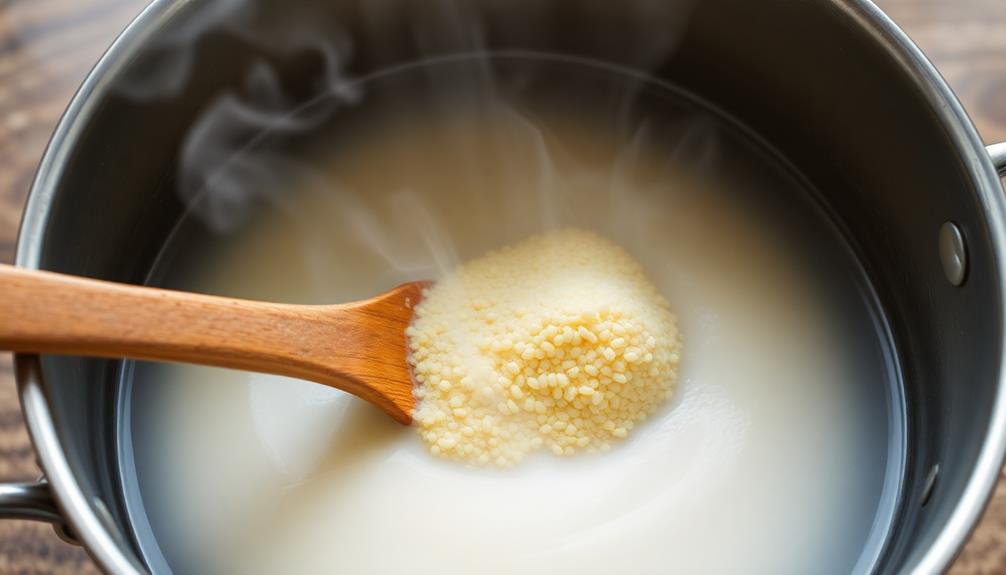
Once the sadza has reached the desired consistency, it's time to incorporate the cornmeal.
Slowly and steadily, begin pouring the cornmeal into the boiling water, stirring continuously with a wooden spoon. This gradual addition is key – you don't want to dump it all in at once!
Keep stirring and adding cornmeal until the mixture thickens to a smooth, porridge-like texture.
Patience is a must during this step. Take your time and let the cornmeal fully incorporate, ensuring there are no lumps or dry spots.
The more you stir, the creamier and more uniform the sadza will become. Once you've reached the perfect consistency, remove the pot from the heat.
Get ready for a delicious, authentic Zimbabwean feast!
Step 3. Reduce Heat and Simmer
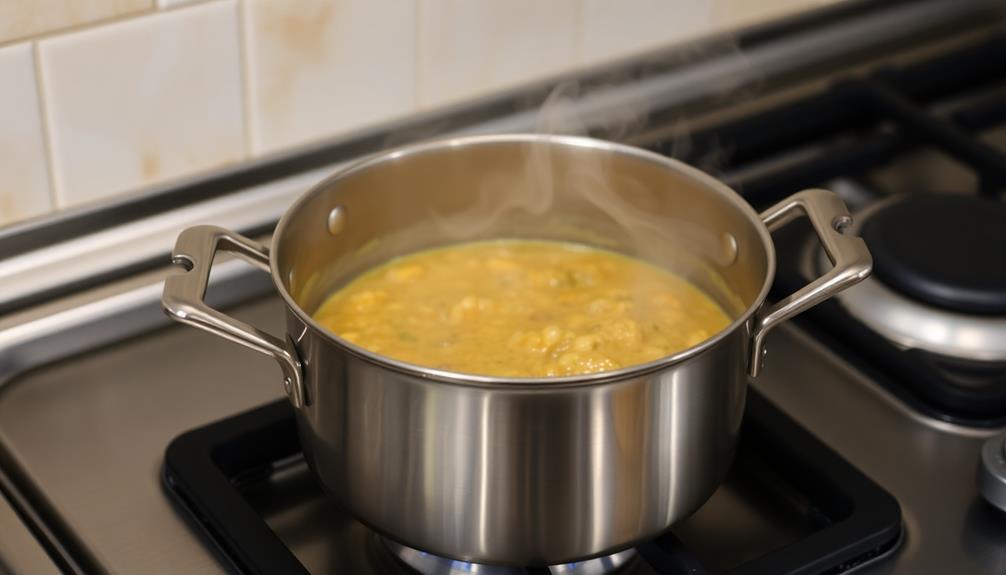
After the cornmeal has been fully incorporated, reduce the heat to low. This gentle simmer allows the sadza to thicken to its signature creamy texture. Stir the mixture continuously, ensuring no lumps form.
You'll notice the sadza start to pull away from the sides of the pot – this is a good sign it's ready!
Once it reaches the desired consistency, about 10-15 minutes, remove the pot from the heat. The sadza will continue to thicken as it cools slightly. Be careful, as the mixture is very hot.
Serve the sadza warm, alongside your favorite stew or relish. It's the perfect comfort food to bring the family together. You can even get the kids involved by letting them help stir the pot.
Sadza is a beloved Zimbabwean staple that's sure to delight all ages. Enjoy this hearty, homemade dish with loved ones.
Step 4. Cover the Pot
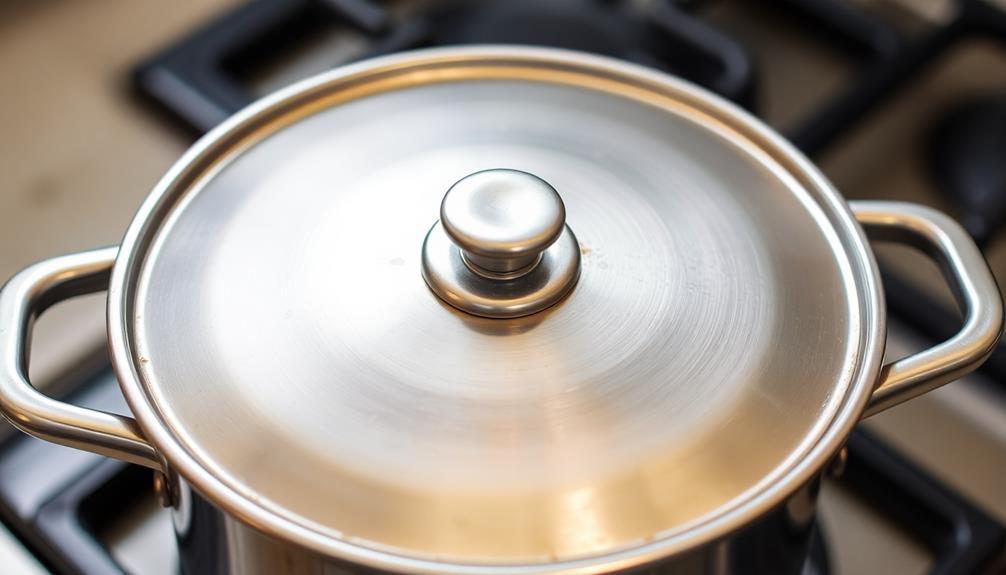
Once the sadza has reached the desired consistency, cover the pot with a tight-fitting lid. This helps the sadza continue cooking and steaming, ensuring it becomes fluffy and light.
Don't be tempted to peek – the steam needs to stay trapped inside to work its magic!
Now, set the heat to low and let the sadza simmer gently for about 10-15 minutes. This gentle cooking allows the starches to fully gelatinize, creating that signature creamy texture.
Resist the urge to stir or disturb the pot during this time – the sadza needs to do its thing undisturbed.
When the time is up, turn off the heat but leave the lid on. Let the sadza sit for 5 more minutes.
This final resting period allows the grains to firm up even more, locking in all that wonderful flavor.
Step 5. Serve Hot With Desired Accompaniment
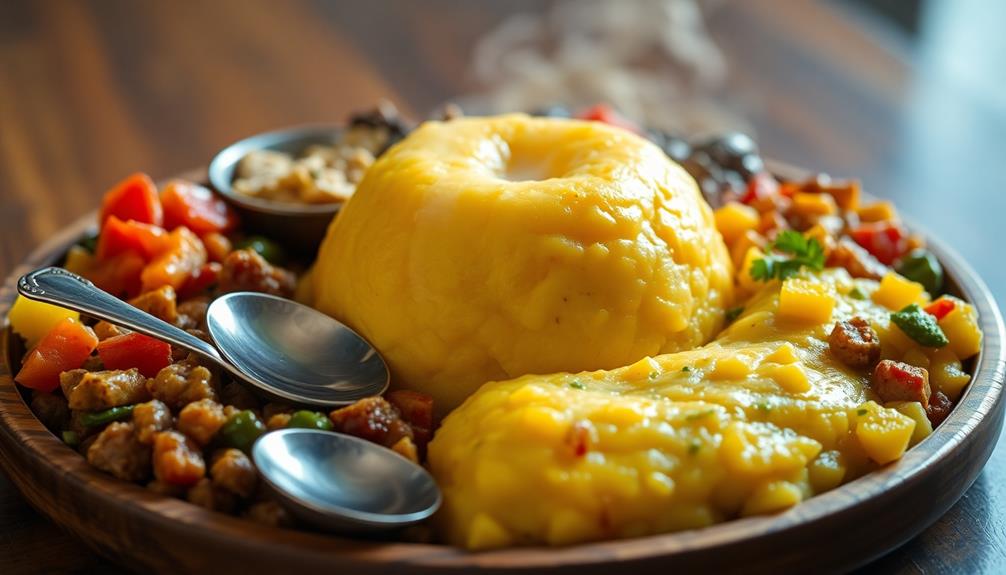
The sadza is now ready to be served hot with your desired accompaniment. Gather your favorite toppings and sides to create a delightful meal.
Consider pairing the sadza with a savory stew, like beef or chicken, for a classic Zimbabwean dish. The stew's rich flavors will complement the sadza's comforting texture perfectly.
For a lighter option, top the steaming sadza with fresh leafy greens, tomatoes, and a tangy relish. This vibrant combination will brighten up your plate and tantalize your taste buds.
Don't forget to offer a selection of condiments, such as hot sauce, peanut butter, or yogurt, allowing everyone to customize their sadza to their liking.
Serve the sadza immediately, as it tastes best when hot and freshly prepared. Encourage your family and friends to gather around the table and savor this beloved Zimbabwean staple together.
The aroma and warmth of the sadza are sure to create a cozy and inviting atmosphere, perfect for sharing a meal and making memories.
Final Thoughts
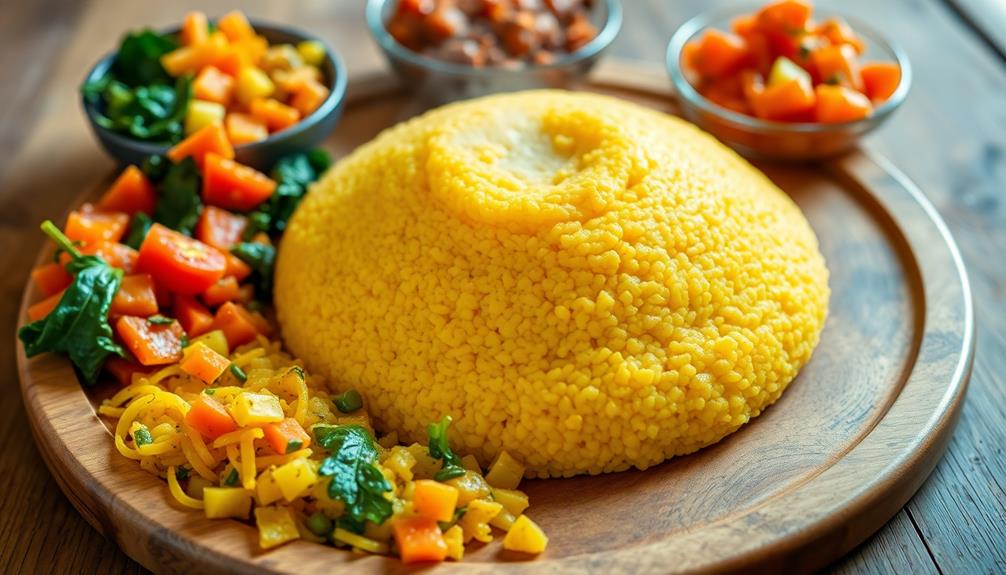
Sadza preparation is a time-honored culinary tradition, evoking a sense of cultural heritage and family gatherings.
Whether you're serving it as a comforting main dish or alongside your favorite stew, sadza truly is Zimbabwe's beloved comfort food.
The process may seem daunting at first, but with a little practice, you'll be whipping up this staple dish like a pro.
As you've discovered, the key to perfect sadza lies in the patience and attention you give to each step.
From meticulously measuring the cornmeal to carefully monitoring the simmering pot, every detail contributes to the final, satisfying result.
And let's not forget the joy of sharing this special dish with loved ones, creating lasting memories around the table.
Frequently Asked Questions
What Is the Nutritional Value of Sadza?
Sadza is a nutritious staple in Zimbabwe, providing complex carbohydrates, fiber, and some protein. It's a good source of energy, though you may want to pair it with additional protein and veggies for a more balanced meal.
Can Sadza Be Reheated and Consumed Later?
Yes, you can easily reheat and consume sadza later. Simply store it in an airtight container in the fridge, and when you're ready to enjoy it, just heat it up on the stovetop or in the microwave.
What Are Some Common Variations of Sadza?
You can enjoy various sadza variations, such as straight sadza, sadza with relish, sadza with peanut butter, and even sweet sadza with milk and sugar. Experiment with different toppings and seasonings to find your favorite version.
How Long Does It Take to Prepare Sadza?
Preparing sadza typically takes 30-45 minutes. You'll need to bring water to a boil, slowly whisk in the cornmeal, and then simmer the mixture until it reaches the desired thick, porridge-like consistency.
Can Sadza Be Frozen for Later Use?
Yes, you can freeze sadza for later use. Once cooled, simply portion it out, wrap it tightly, and store it in the freezer. When ready to enjoy, thaw it and reheat gently on the stovetop or in the microwave.



